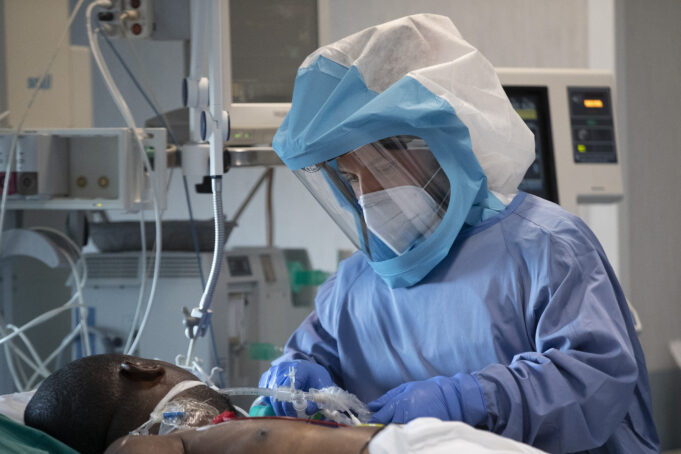Nurse Maurizio di Giacobbe tends to a patient in a COVID-19 ICU of the Tor Vergata Polyclinic Hospital, in Rome, Italy, Dec. 13, 2020. The coronavirus pandemic has posed unprecedented challenges for families around the world managing work and home life with children kept home from school and after-school activities.
For the Di Giacobbe family, the juggling is even more complicated since mom and dad are intensive care nurses in the same COVID-19 ward and spend their days tag-teaming shifts, trying to give their patients the level of personal care and attention they would give their own children.AP Photo/Alessandra Tarantino
ROME—The variant of the coronavirus discovered in Britain is prevalent among Italy’s infected schoolchildren and is helping to fuel a “robust” uptick in the curve of Covid-19 contagion in the country, the health minister said recently.
Roberto Speranza told reporters March 2 that the variant, associated with higher transmission rates, has shown pervasiveness “among the youngest age group” of the population.
In recent weeks, Italy’s incidence of new cases among young people has now eclipsed incidences among the older population, a reversal of how Covid-19 afflicted residents in the first months of the pandemic.
Italy, a nation of 60 million people where Covid-19 first erupted in the West in February 2020, has registered nearly three million confirmed cases.
Health Minister Speranza announced stricter directives, contained in the first anti-pandemic decree of new Italian Premier Mario Draghi, aimed at trying to “govern this curve of contagion,” especially among school-age children.

There are “rather robust signs of an uptick in the curve of contagion and terrible variants,” particularly the one discovered in Britain, the minister said.
The president of the government Superior Institute of Health, Silvio Brusaferro, said that as of analyses of cases on Feb. 18, 54 percent of confirmed Covid-19 cases in Italy involved that variant. But, said Mr. Brusaferro, “if measured today surely the percentage would be higher.”
Another variant, found in Brazil, is now involved in 4.3 percent of recent Covid-19 cases in Italy, Mr. Brusaferro said, particularly in central Italy, including the area of Rome’s region.
In recent days, authorities have taken to sealing off many towns and cities in areas where transmission rates are rapidly increasing. The mayor of Bologna, which has 400,000 residents, announced that, starting on March 4 and until March 21, the city will be under strict “red zone” lockdown rules, which means all restaurants and cafes are closed to dining, as are nonessential shops.
Another critical place is Como, the lakeside city near Switzerland. Many of Como’s citizens commute across the border.
The variant found in South Africa is involved in 0.4 percent of Covid-19 infections in Italy and mainly confined to the Italian Alpine area near the border with Austria, Mr. Brusaferro said.
Mr. Draghi’s decree, which took effect on March 6 and lasts until April 6, to just after Easter, tightened measures governing schools. It mandates that all schools, including for nursery and elementary students, in “red zone” regions must be shuttered. Some exceptions will be made for students with special needs.
But the decree loosens restrictions in the world of culture. Starting on March 27, cinemas and theaters can reopen in “yellow zone” regions with low incidence and virus transmission rates, but these venues must limit capacity to 25 percent. Museums in yellow zones, already permitted to admit the public on weekdays, can open also on weekends starting March 27.
Gyms and pools stay shut. Also remaining is a 10 p.m. to 5 a.m. nationwide curfew, and a ban on travel between Italy’s regions.
Italy’s known death toll of more than 98,000 is the second-highest in Europe, after Britain’s. (AP)













